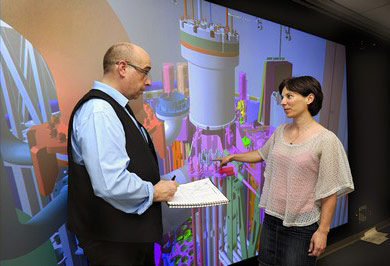A research reactor for testing and qualifying fuels and materials under irradiation
Studies related to fuel and structural material behaviour under irradiation are a fundamental challenge in terms of safety and competitivity of current and future nuclear power plants and their lifetime extension.
The JHR will allow these studies to be performed quickly and safely. With its technical and scientific platform and the broad scale of tests proposed, the JHR will be a unique experimental tool for observing and understanding material behaviour in an extreme nuclear environment.
The JHR: a very efficient research tool
The JHR is an experimental reactor. As opposed to a production reactor, it is not intended to generate electrical power, but only to provide scientific data concerning nuclear fuel and material behaviour when they are exposed to very high stresses (high neutron fluxes).
The JHR will submit the samples of components that researchers or industrial partners would like to test under an intense neutron flux. Within JHR experimental devices, theses samples may also be exposed to extreme pressures and temperatures if required. These components will thus undergo accelerated ageing, and will be pushed beyond the limits of their normal use, if required up to incidental and accidental situations, which will allow an experimental qualification before their use in industry.
The JHR: a supplier of radioelements for the nuclear medicine sector
The JHR will also be used for nuclear medicine. It will supply hospitals with short-lived radioelements used by medical imaging units for diagnostic purposes. These radioelements, such as technetium-99m, have a limited lifetime of a few hours.
They therefore need to be produced on an ongoing basis. The JHR will contribute to 25% of the European production of these radioelements on a yearly average or even up to 50% if required.
Enhanced safety standards for research reactors
The JHR is built in compliance with the highest level of safety required by the French nuclear safety authority (ASN):
- Increased resistance to seismic loading
- Containment building resistant to external hazards
- Separated emergency diesels
- Emergency heat sink in air
- Backup control panel
An international project
The JHR project, currently under construction at CEA Cadarache site, gathers within an international consortium around the CEA, French industrial partners EDF and AREVA, the European Commission, together with Belgian, Czech, Spanish, Finnish, Indian, Israeli, Swedish and British research institutes, the CEA being the owner, nuclear operator and contracting authority.
In exchange of their financial participation, JHR consortium members will benefit from guaranteed access to experimental capacities of the facility to carry out their own research on material behaviour under irradiation.

Working meeting - JHR © L. Godart/CEA